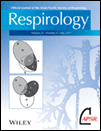 Autores: Camyla F. de Farias, Maria M.F. Amorim, Michel Dracoulakis, Lilian B. Caetano, Ilka L. Santoro, Ana L.G. Fernandes
Autores: Camyla F. de Farias, Maria M.F. Amorim, Michel Dracoulakis, Lilian B. Caetano, Ilka L. Santoro, Ana L.G. Fernandes
Respirology Volume 22, Issue 4 May 2017 Pages 671–677 • doi:10.1111/resp.12958
Abstract:
Background and objective
Determination of asthma phenotypes, particularly inflammatory phenotypes, helps guide treatment and management of this heterogeneous disease. Induced sputum cytology has been the gold standard for determination of inflammatory phenotypes, but sputum induction is fairly invasive and technically challenging. Blood and nasal lavage cytology have been suggested as substitutes, but have not been fully verified. The aim of this study is to determine the accuracy of blood and nasal lavage cytometry as indicators of inflammatory phenotypes in asthma.
Methods
Clinical evaluation, Asthma Control Questionnaire (ACQ) and spirometry were performed for 121 adult asthma patients, and blood, nasal lavage and induced sputum samples were taken. Eosinophils and neutrophils were counted in three samples from each subject. Inflammatory phenotypes (eosinophilic, neutrophilic, mixed and paucicellular) and cells counts were analysed using Venn diagram and receiver operating characteristic (ROC) curve, respectively.
Results
ACQ score, spirometry and bronchodilator response did not differ among subjects with different inflammatory phenotypes. Inflammatory phenotypes defined by nasal lavage cytometry were in better concordance than those defined by blood cell counts with phenotypes determined by sputum cytology, and were significantly correlated with sputum phenotypes. For eosinophilia, nasal lavage cytology showed better accuracy than blood cytology (area under the curve (AUC): 0.89 vs 0.65). For all phenotypes, sensitivity and positive and negative predictive power were higher for nasal lavage cytometry than for blood. Blood cell counts gave a high level of false positives for all inflammatory phenotypes.
Conclusion
We recommend nasal lavage cytology over blood cell count as a substitute for sputum cytology to identify inflammatory phenotypes in asthma.


